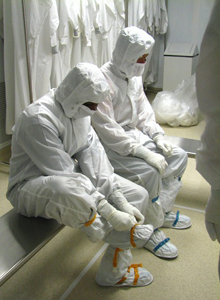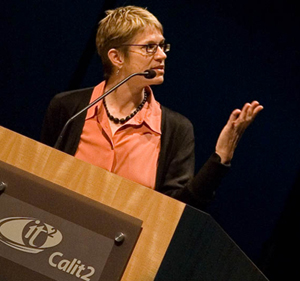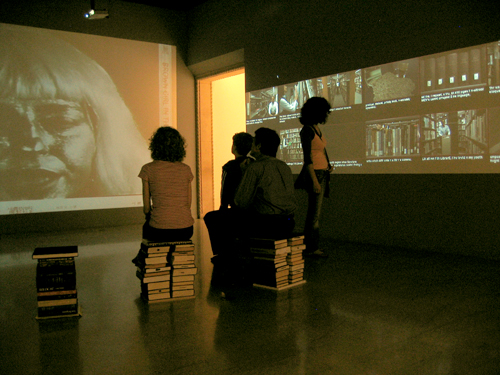Particles of Interest: An Interview with *particle group*, by Eduardo Navas

Images and text source: gallery@calit2
Note: The following is an interview published for the exhibition SPECFLIC 2.6 and Particles of Interest: Installations by Adriene Jenik and *particle group* on view from August 6 to October 3, 2008 at gallery@calit2. In this Interview *particle group* shares its critical approach on the ever growing nanoparticles market.
*particle group* is a collective consisting of Principal Investigators Ricardo Dominguez and Diane Ludin, as well as Principal Researchers Nina Waisman (Interactive Sound Installation design)and Amy Sara Carroll, with a number of others flowing in and out. The collective draws from the hard and social sciences to develop installations that are critically engaged with the politics of science and its market. Their aim with the installation “Particles of Interest” is to shed light on the lack of regulation of nanoparticles in consumer goods. In the following interview the *particle group* shares its views on the current state of nanotechnology production, as well as a possible future that we may all be facing, in which nanomachines just might make difficult decisions for us.
[Eduardo Navas]: How does collaboration take place within the *particle group*? You describe members’ roles as Investigators and Researchers. Could you explain how these terms are relevant to each collaborator’s contribution to the project?
[*particle group*]: We mimic the structure of a research and development model for a university laboratory. By laboratory we mean a group of individuals who pursue conceptual investigations determined by a chronology of work that the Investigators have determined. Here, though, it should be noted that already we morph the template as Principal Investigators become Principle Investigators, homonymically signalling our investments in science’s narrative “engines of creation,” the aesthetic/ized practices and/or “naturalized” conceptualisms inherent in research, investigation, discovery and data transfer within scientific communities’ “normalized” articulations of self.
Generally the researchers participate from the beginning stages of materializing/performing/manifesting the work that the collective *particle group* eventually presents in counter/public spheres as varied as the art museum, the mall, and/or the scientific meeting. Researchers work in tandem with Investigators to develop their interpretations of the subject matter under investigation, augmentation, and/or erasure. So each time we are invited (or invite ourselves) to stage an iteration of our research, we meet and discuss via Skype or email what our intentions should be for the “performance.” To date we have had a different crew of researchers for each presentation so inherent in particle group’s particularization and particle-ization is a revolving/open door policy toward creative maelstroming. This project was produced in large part by Calit2, and so it made aesthetic sense to us to approach the project as would-be art(is)cientists and to stage a series of p(our)-us epistemologies (on the testbeds of these strange viroids of art and science) and not to see the gesture of art and science as two bunkers at war — but as possible thought-scapes of concern under the sign of “nano-ethics and nano-constructions.” Each one as blind as the other, each one helping the other over the rocking shoals of Particle Capitalism(s).











